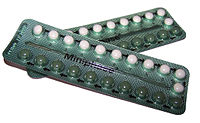
Photo from wikipedia
Objective: High-intensity focused ultrasound (HIFU) is an innovative non-invasive technology used for adenomyosis. Gonadotropin-releasing hormone agonist (GnRH-a) is a hormone commonly used for adenomyosis. We investigated and assessed the efficacy… Click to show full abstract
Objective: High-intensity focused ultrasound (HIFU) is an innovative non-invasive technology used for adenomyosis. Gonadotropin-releasing hormone agonist (GnRH-a) is a hormone commonly used for adenomyosis. We investigated and assessed the efficacy of HIFU combined with GnRH-a for adenomyosis. Methods: For this systematic review and meta-analysis, we searched Pubmed, Cochrane Library, Web of Science, Embase, CNKI, WanFang, and VIP databases for relevant articles published in Chinese or English that compared HIFU combined with GnRH-a vs. HIFU alone in patients with adenomyosis. The last literature search was completed on January 31, 2021. Two reviewers independently assessed study eligibility and assessed risk of bias. Another two reviewers extracted the data. The RevMan5.3 software was used for the data analysis. Changes in volume of the uterine and adenomyotic lesion were defined as the primary outcomes. The secondary outcomes were visual analog scale (VAS) scores for dysmenorrhea, menstrual volume scores, serum CA125 levels, and recurrence rate. This study is registered with PROSPERO (CRD42021234301). Results: Three hundred and ninety potentially relevant articles were screened. Nine studies with data for 766 patients were finally included. Compared with the HIFU alone group, the HIFU combined with GnRH-a group had a higher rate of uterine volume reduction (MD 7.51, 95% CI 5.84–9.17, p < 0.00001), smaller adenomyotic lesion volume (MD 4.11, 95% CI 2.93–5.30, p < 0.00001), lower VAS score for dysmenorrhea (MD 1.27, 95% CI 0.54–2.01, p = 0.0007) and menstrual volume score (MD 0.88, 95% CI 0.73–1.04, p < 0.00001), and lower CA125 level (SMD 0.31, 95% CI 0.05–0.56, p = 0.02) after the procedure. The recurrence rate in the HIFU combined with GnRH-a group was lower than that in the HIFU alone group (RR 0.28, 95% CI 0.10–0.82, p = 0.02). Conclusions: Compared with HIFU treatment alone, HIFU combined with GnRH-a for the treatment of adenomyosis has greater efficacy in decreasing the volumes of the uterine and adenomyotic lesions and alleviating symptoms. However, since the number of the included studies was too small and most of them were written in Chinese, this conclusion needs to be referenced with caution. And the long-term evidence of its efficacy is still insufficient. Systematic Review Registration: https://www.crd.york.ac.uk/prospero/ identifier [CRD42021234].
Journal Title: Frontiers in Public Health
Year Published: 2021
Link to full text (if available)
Share on Social Media: Sign Up to like & get
recommendations!